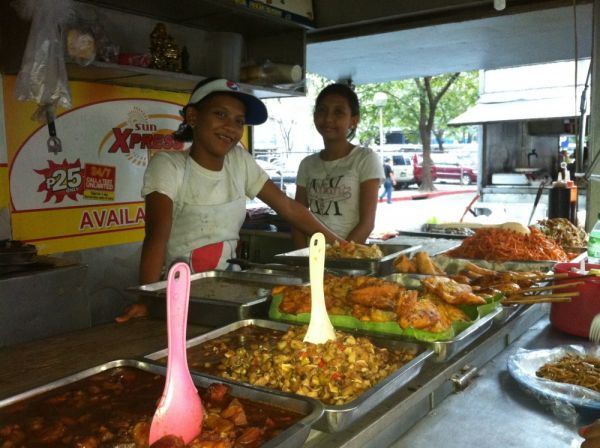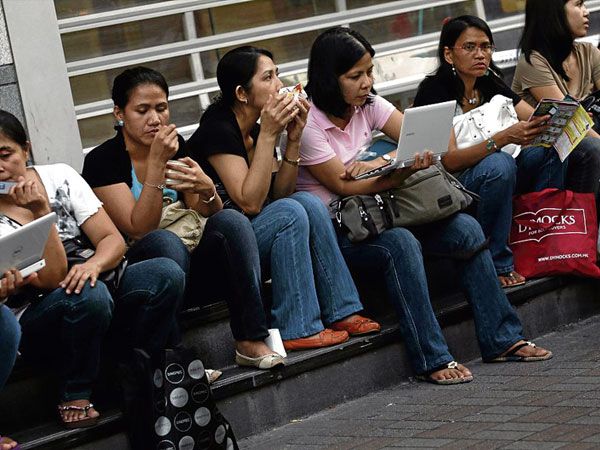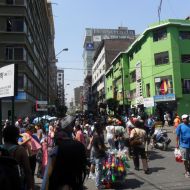Multi-Hyphenated Before It Was Cool

Jolly jeep workers selling food in Quezon City. Photo credit: Purple Romero
Multi-hyphenated. This is what they’ve called this generation, a generation of people departing the nine-to-five existence and doing as many things as they can. Becoming writers, artists, teachers, selling things online, even becoming financial advisers – all at the same time. One person, different hats.
But before it was fashionable to do so, before “multi-hyphenated” became a buzzword, it was simply reality for people who lived their lives in informal systems. This is what I have learned while writing for the Informal City Dialogues. I’ve met people who hold down more than one job not only to survive, but more importantly, to grow and affect change on a larger scale.
One example is the women who tend the vegetable garden that sits in the middle of a community known for poverty and petty crimes. These women belong to the Kabalikat sa Pagpapaunlad ng Baseco (Allies for Improving Baseco).
Baseco is one of the biggest areas inhabited by informal settlers in Manila. The urban garden serves as a source of food and funds for the group. As they garden, the members sets aside part of their dues as savings. The money is then used as payment for the land that the government promised, way back in 2001, to turn over to them.
These women have other jobs – they tend the garden after they are done washing clothes, or after selling food they’ve cooked to sell to students, laborers and their neighbors. These are women who do manual jobs to earn money, participate in an innovation called urban gardening and contribute to disaster risk reduction. They belong to the informal sector and they are part of the multi-hyphenated generation.
There’s more. In May, just in time for the midterm elections in the Philippines, I met another woman in Navotas who worked as a street sweeper in the morning, then campaigned, house-to-house, at night for a partylist group she wants to win in the Congressional elections. She is a hardworking mother and a political animal.

Domestic workers in Manila.
These people live multi-hyphenated lives not to strengthen their brand of individualism, as many young people do, but because they must to survive, and sometimes, to shake up structures and change the status quo. The women in Baseco want the government to make good on its word. They are more than ready to pay for the land they are due with the money their group has saved, destroying the notion that informal settlers want nothing but a handout.
The campaign volunteer in Navotas wants her partylist group to win so that they, the urban poor, will have a say in the lawmaking process, which has been dominated by political dynasties that use the 3 G’s – guns, goons and gold – to strengthen their hold on power.
Similar to these women are two men I interviewed in Philcoa, Quezon City, who are unconsciously challenging the old business models. One of them is Mark Bautista, who sells slippers and shoes on the Philcoa overpass. Bautista looks Korean, but when he spoke, he had an accent that unmistakably belongs to Filipinos who hail from the region of Visayas. It was drizzling, and Bautista was holding an umbrella and sitting on the left side of the overpass when I approached him. Beside him was a mat covered with 25 pairs of shoes and slippers.
“I sell them every day from 5 p.m. to 10 p.m.,” he said. He buys P7,500 ($170 USD) worth of shoes and slippers every Wednesday and Saturday in Baclaran, where cheap goods are plenty, and sells them at P50 ($1) each, earning P600 ($13) daily, which is double what he used to earn as a factory worker.
When I asked him what does before 5 p.m., he said that he tends to his other “store,” which is located in Commonwealth, over 30 minutes away. He and his mother also sell slippers and shoes there, where they have a spot on the sidewalk in front of a mall.
“We earn more. We sell as much as P1,900 ($43) a day,” he said. With his earnings higher than his previous salary, Bautista, who is only 23, said he does not plan to seek formal employment soon. “We will never be regularized anyway.”
The overpass that Bautista works on in Philcoa is a bridge between two worlds, separated by the socioeconomic standing of the residents in the two neighborhoods that Philcoa covers. One area is Maginhawa, which in English means “prosperous.” Lining Maginhawa are food establishments that cater to students from the University of the Philippines and professionals that work or live in Quezon City. The other part of Philcoa – the one on the left side of the overpass — has food, too: The kind you eat standing up.
A popular item over there is the “street chickenjoy,” a reference to the fried chicken being sold in Jollibee, the biggest fast-food chain in the country. Street chickenjoy is sold from food carts for P10 to P12 each.
One of those who sells it is JR Francisco, a 28-year-old father of seven. Not just a vendor, Francisco provides 40 kilos of his street chickenjoy to three other vendors, who sell them in other parts of Quezon City. He also sells 15 kilos of his fried chicken to people who then sell them from their carinderias, or food stalls, earning enough to recoup his P3,500 ($79) in expenses each day.
“I learned this from another seller of street chickenjoy,” he said, gesturing to a food cart further down the street that’s twice as big as his. Francisco said he worked for them for a couple of months. When he learned how to cook street chickenjoy, he decided to sell it on his own, taking on other side jobs like construction.
“I will wake up at 3 a.m., buy chicken at the market and then prepare them. By nine, I’m off to the construction site,” he said. “My wife will sell them until 6 p.m. Then I will arrive and help her sell them until 12 midnight at times.”
Francisco said that juggling the two jobs is a must. “If you don’t work hard, you won’t be able to live,” he said.
Francisco and Bautista have honed their business sense through their experience on the streets. I wouldn’t be surprised if I someday see them with their own stalls in a market or even the mall.
Their roots are in the informal economy, however. The kind of flexibility that it provides helped them become more creative and find their niche in the world of urban consumers. They are members of the multi-hyphenated generation, unbound by time and the rules of a nine-to-five existence. These are the kind of people I met while blogging for the Informal City Dialogues. They are changing the face, culture and color of the cities they live in — and in doing so, they are changing the future of Manila.









